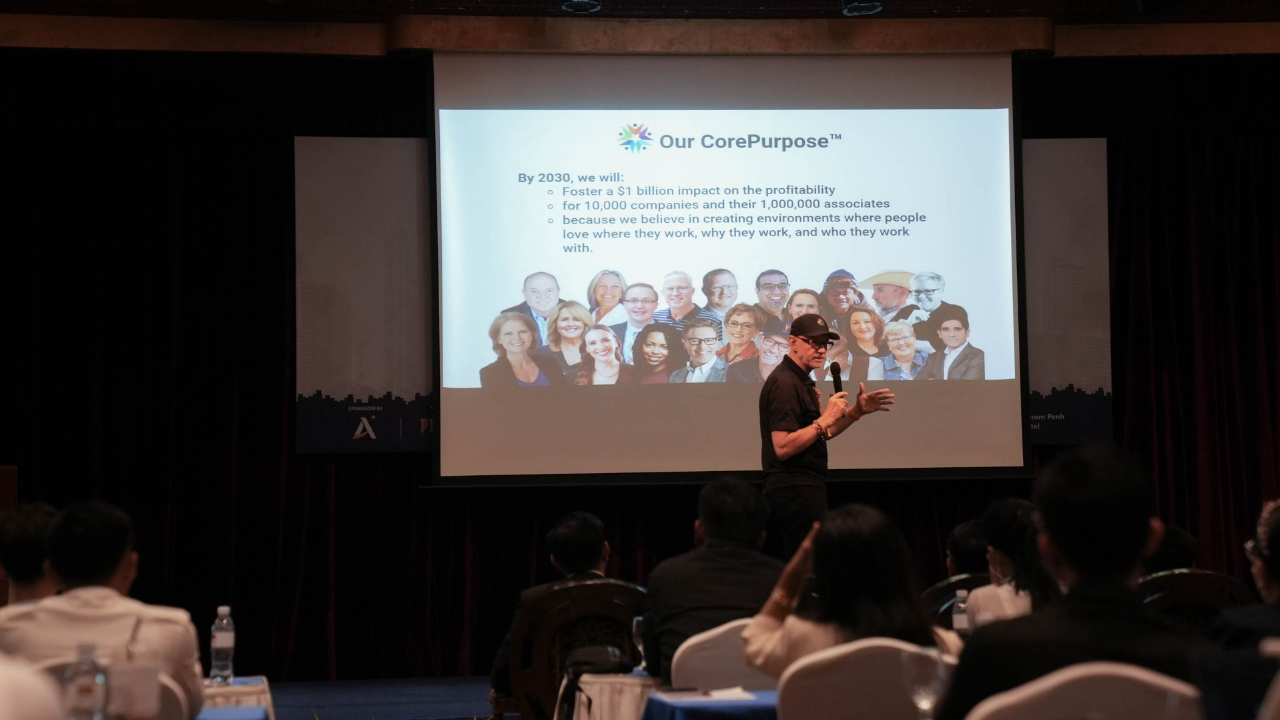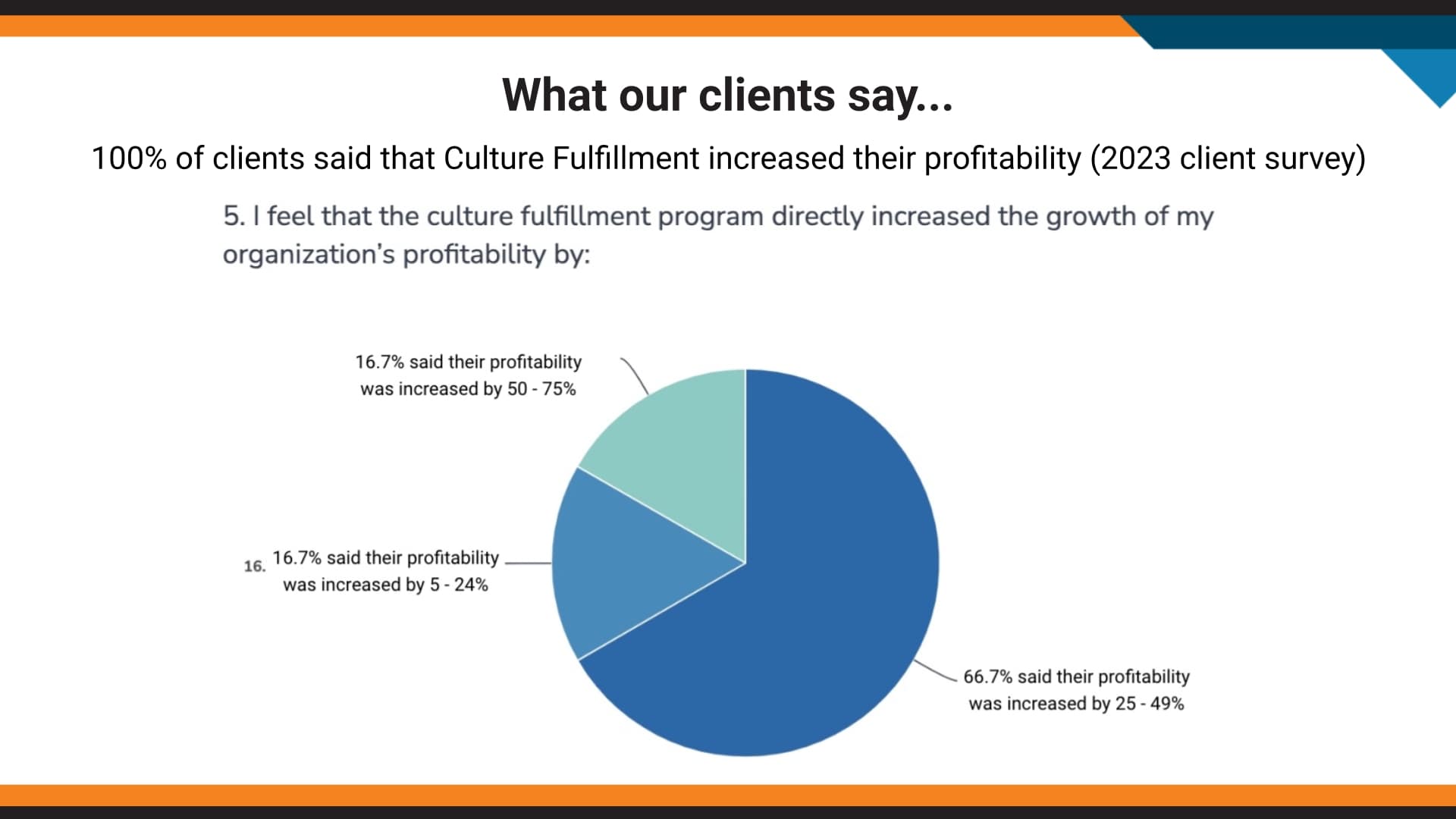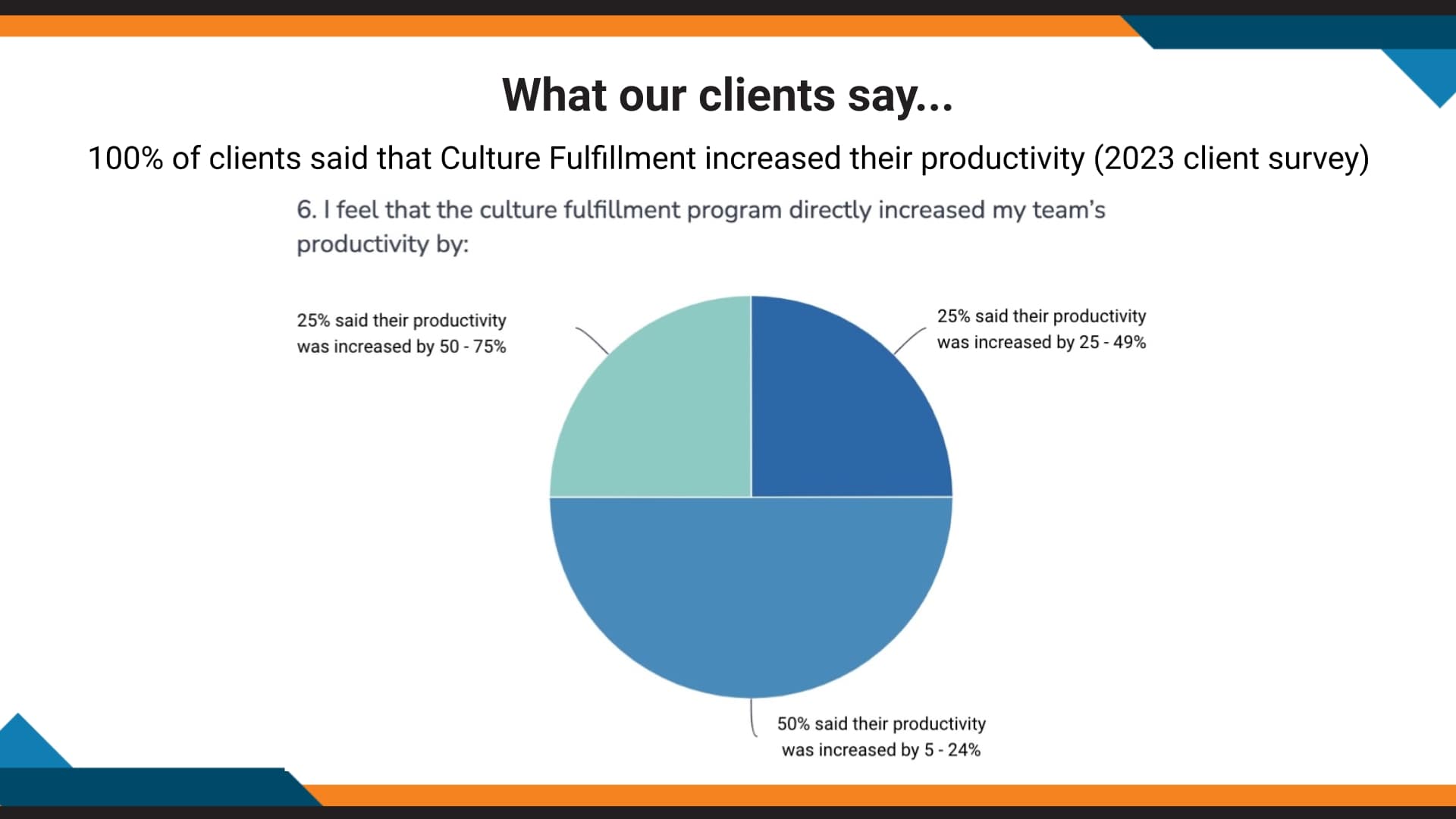3 Company Culture Transformation Strategies To Increase Profit In 12-24 months.

“Some business leaders think they’re leading a company. I say, you’re leading a culture”
- Will Scott, Founder & Author of The Culture Fix®
Companies are continuously looking for techniques or tools to acquire a competitive edge and boost profitability. While conventional strategies like marketing and sales are important, organizational culture is an often-overlooked factor that can result in considerable financial gains. Take a look at the results of our 2023 eNPS Survey.

100% of our clients reported that our Culture Fulfillment program increased their company’s profitability. How?
Company culture drives profit by reducing employee turnover.
Businesses that have high employee churn incur costs for recruiting, training, and onboarding new employees. Research by The Society for Human Resource Management (SHRM) suggests that replacement costs can be as high as 50%-60% of employee-replaced salary, with total costs ranging anywhere from 90%-200% of employee-replaced salary.
For example: If an employee makes $60,000 per year then it costs an average of $30,000 - $45,000 just to replace that employee, and roughly $54,000 - $120,000 in overall losses to the company, due to the resources (time, training, etc.) required to hire and onboard new employees.
When employees feel valued, supported, and recognized at work, loyalty is increased and turnover rates are down. Companies with engaged staff, according to Gallup, see 59% reduced attrition, which translates into significant cost savings. In today's highly competitive market, employees have higher expectations from the companies they work for. These expectations are closely tied to their values. When employers meet these expectations, they tend to have more loyal and productive employees, leading to improved business outcomes and company growth.
Companies with strong cultures have experienced four times the increase in revenue growth. Moreover, companies featured on Fortune's annual "100 Best Companies to Work For" list have also witnessed higher average annual returns, with cumulative returns reaching as high as 495% instead of 170% (Russell 3000) and 156% (S&P 500).
This leads into the 2nd way company culture drives profit…
Company culture drives profit by increasing employee engagement - attracting top talent & increasing teams’ productivity.
More engaged workers = Increased productivity.According to a Gallup poll, actively disengaged employees cost U.S. companies between $450 – $550 billion in lost productivity per year. Productivity Growth Employees are more motivated, engaged, and productive when they feel a connection to their work and share the company's values and goals. According to a University of Warwick study, contented workers produce 12% more than their unhappy counterparts. Greater efficiency, increased output, and eventually higher profitability are all results of higher productivity.
Another result is attracting top talent. High achievers actively seek out other high achievers to collaborate with. Their motivation stems from the fact that by working together, they can challenge each other to reach greater heights. They establish a supportive network that nurtures growth, learning, and continuous improvement. Moreover, they value the opportunity to collaborate with colleagues who also possess a strong drive for success and take responsibility for their actions. Conversely, they do not appreciate working alongside teammates who consistently miss deadlines and exhibit low standards. Consequently, exceptional cultures are characterized by a high level of accountability, encompassing both intellectual and emotional aspects, as well as proficiency in both technical and interpersonal skills.
In fact, it is not uncommon for the most outstanding performer, the unequivocal top performer, to leave a company if they find themselves surrounded by colleagues who do not match their level of dedication. The underlying truth is that collaborating with other top performers establishes an environment that fosters excellence. This environment cultivates a culture of achievement, where expectations are continually elevated.
Talented people looking for meaningful work environments are drawn to organizations with a great company. A company attracts high-performing candidates who are more likely to contribute to the success of the organization when it is known for its strong culture and principles. Innovation, problem-solving, and general business performance are all improved by having access to elite personnel.

100% of our clients have reported that our Culture Fulfilment program increased their company’s productivity.
Company culture drives profit by fostering innovation, creativity, resourcefulness, & resiliency.
These characteristics cannot be quantified, but it’s clear they make or break a company - especially in the age of AI. According to a study by Boston Consulting Group, companies that prioritize innovation have 2.6 times higher revenue growth and 50% higher operating profit margins compared to their industry peers. Additionally, the 2018 Adobe State of Create Report revealed that companies fostering a creative culture experience 1.5 times higher market share gains and 1.5 times higher likelihood of being recognized as innovative leaders in their industry.
Utilize The Culture Fix® Tools to address each of these points:
Reduce Employee Turnover.
Yearly turnover rates can be calculated by taking the number of separations during any given year divided by the average number of employees during that year.
Example: 100 [(10 employee separations) / (50 average employees)] = 20% turnover rate. Reflect on why those employees separated, and make an actionable plan for how to reduce this number in your company goals.
Take stock of your company values, or CoreVals™. Identify the core principles that define your company's identity and foster a culture of shared purpose. Define and communicate these values. Make careful to express these principles in clear terms and to ensure that everyone in the organization is aware of them. To emphasize the significance of these principles, use a variety of media, including business meetings, internal communications, and training programs, and display graphically using a CoreChart™.
Ensure that the business leaders lead with core values. Setting the tone for an organization's culture requires strong leadership. To set an example for the rest of the business, leaders must live by the organization's basic values. Their acts and conduct ought to reflect the intended culture and exhibit honesty, openness, and deference. People are more likely to prioritize culture when leaders do.
Then…
Hire people who already identify with your company’s values is an indicator they will succeed and contribute to your company culture. You can achieve this by implementing the Core People Processes™, which include protocols for hiring, unhiring™, and evaluating employees based on CoreVals. This evaluation is called a CoreScore™.
We encourage you to implement the CoreScore™ to measure the degree to which your employees or potential employee work in concert with your CoreVals. Take a look at the scale below which helps you rate each employee.
- Do they/would they align all of the time? = 3
- Do they/would they align most of the time? = 2
- Do they/would they align some of the time? = 1
- Do they/would they align none of the time? = 0
Engage your team and attract top talent.
The first step is implementing the Core People Processes™, which include protocols for hiring, unhiring™, and evaluating employees based on CoreVals. These processes, along with the Core Workflows™, are crucial business procedures that can significantly impact your company's culture. This framework allows a basis for:
Notice & Nominate™ Celebrate and thank employees for their contributions and achievements by recognizing them.
Organize processes & allocate time for recognition that draw attention to exceptional accomplishment and reaffirm the desirable attitudes and values.
Employee recognition and rewards not only increase morale but also develop an encouraging culture of gratitude and motivation.
Assessing and adjusting company culture on a regular basis. Evaluate the success of your cultural initiatives, get employee feedback, and make the required corrections. Develop an environment where continual improvement and adaptation are valued, and make sure that the culture of your business changes to reflect the demands and dynamics of your workforce as they change.
While these practices are particularly effective during growth and when adding new team members, it's equally important to have a system in place for removing or unhiring individuals who have a negative impact on your culture. We prefer using the term "unhire" instead of the more commonly used term "firing" because it implies a more mutually agreed-upon action and acknowledges the employer's or hiring manager's responsibility in a hiring mistake. Before “unhiring,” we recommend utilizing Catch & Correct™ - using your core values as a neutral reference point when an associate is working in misalignment with the organization’s values, thus catching & correcting this behavior before it is a larger issue for the company. Your company is only as strong as it’s weakest employee, and as we mentioned before, top performers want to work with other top performers.
Leading a culture that values its employees naturally results in the attraction and retention of top talent.
Individuals with exceptional skills and a desire for meaningful work are naturally drawn to organizations that have a stellar reputation. A company that is known for its strong culture and principles has the ability to attract high-performing candidates who are more likely to make significant contributions to the organization's success. This access to elite personnel leads to improvements in innovation, problem-solving, and overall business performance.
Foster a company culture that encourages innovation, creativity, resourcefulness, & resiliency.
This begins by promoting an inclusive culture that celebrates diversity and encourages equal opportunity for all workers by embracing diversity and inclusion. Encourage a variety of viewpoints and give everyone in the organization a sense of belonging. Accepting diversity increases the company's reputation and makes it more appealing to a wider range of customers while also fostering creativity and innovation.
Create an environment of psychological safety that encourages taking risks.
In HBR Ideacast episode, cultures that excel in creativity and innovation have the ability to embrace risk-taking, even when those risks don't lead to immediate success or when innovative ideas don't pan out as expected. If the risk-taking was approached with thoughtful analysis and robust processes, it should be celebrated regardless of the outcome.
Again, we recommend implementing Notice & Nominate™ to reward creative risks and innovative thinking. This democratises creativity, while also making the efforts palatable by tethering it to the greater mission of the collective. This also helps workers feel connected, which enriches and encourages collaboration.
Focusing on company culture provides real financial advantages that have a noticeable positive effect on a company's profitability. Companies can benefit from higher productivity, better employee retention, greater customer happiness, the attraction of top talent, and a stronger reputation for their brands by cultivating a happy work environment.
Leadership commitment, effective communication, empowerment, recognition, and an inclusive strategy are necessary to develop a good company culture. Investing in a company's culture becomes a crucial success factor as it adapts and changes. Companies may tap into the lucrative potential of their organizational culture and position themselves for long-term growth and prosperity by putting their employees first and fostering a positive work environment.


